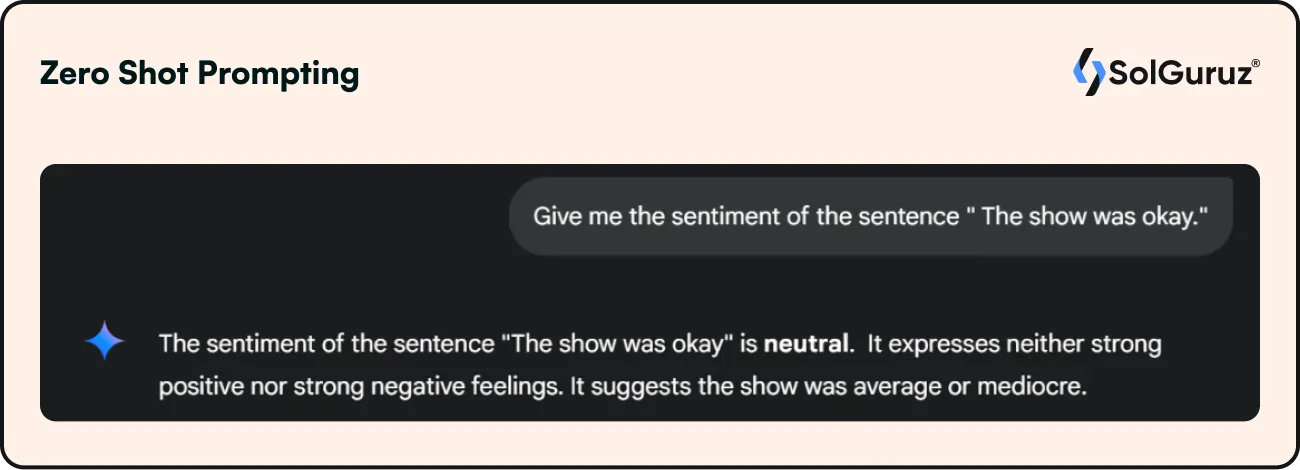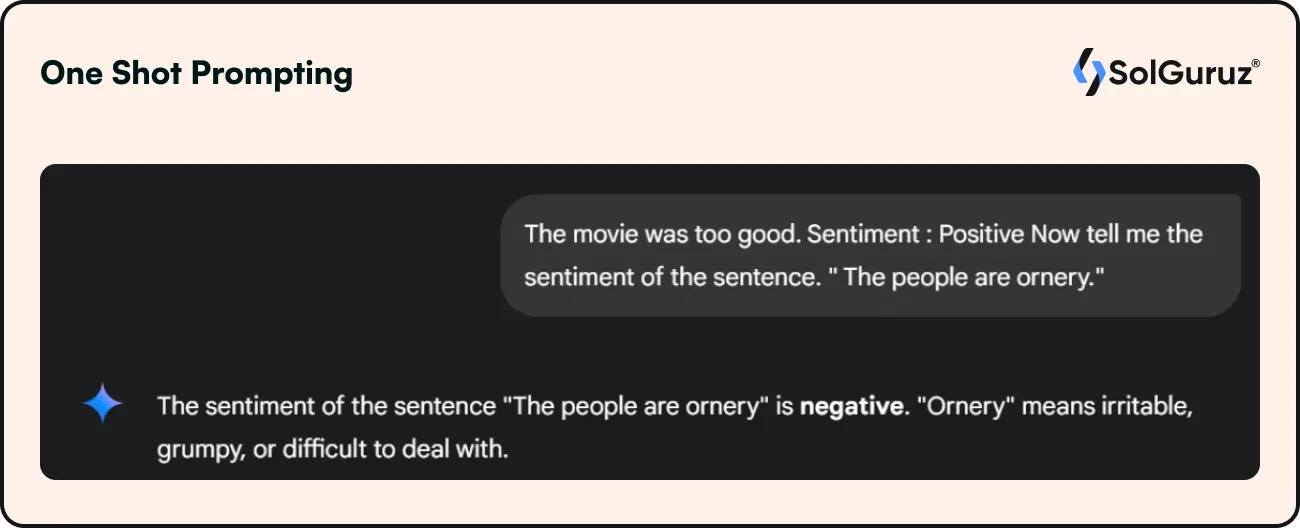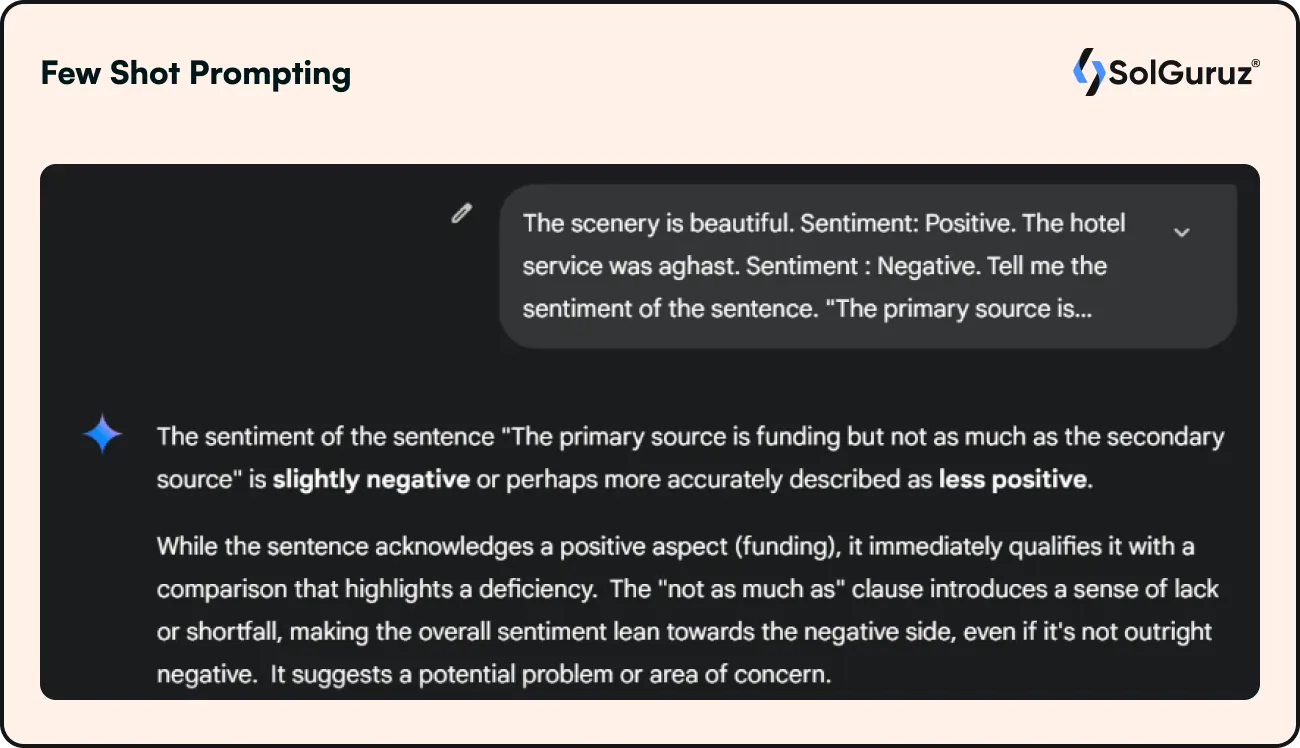Zero-Shot, One Shot, Few Shot Prompting
Zero-shot, one-shot, and few-shot prompting are techniques that shape how AI models respond to tasks. This article explains each method, when to use them, and how they impact accuracy, consistency, and cost in real-world AI applications.
Today’s topic is taking prompt engineering and prompting a bit in detail.
In our Gen AI Wiki series, we go in-depth and cover as many topics and basics as we can.
Prompt engineering is based on prompts.
In case you want to go back to the basics, like what is prompt engineering, we’ve got you covered.
This Gen AI Wiki covers the different prompts in detail and how they are used.
What is ZERO Shot, One Shot, and Few Shot Prompting?
Shot-based prompting is closely knit to in-context learning.
In-context learning occurs when only prompts or instructions are insufficient; you need to provide additional structure or format to get the output in a particular format. Let’s discuss each of them in detail-
Zero-Shot
Training machine learning models to identify novel classes in the absence of labeled data is known as "zero-shot learning." These models use their prior knowledge and semantic similarities to generate predictions rather than depending on labeled samples.
For example, a zero-shot learning algorithm may use its knowledge of other polar bear species to predict the likelihood of correctly identifying a Chow Chow.
A chow chow indeed is a dog breed that looks like a polar bear and is found in cold regions. However, zero-shot prompting is based on no pre-defined training, so it uses its own knowledge and training to answer the question.
In the example prompts below, we are using one example for zero-shot, one-shot, and few-shot prompting. We have kept it uniform in all three cases better to reflect the differences between the three prompting styles.
Example prompt for Zero-shot

In the above prompt, no training or reference was given to the model to generate the response. Hence, zero-shot prompt.
One Shot
By giving a single example prior to the new assignment, one-shot prompting improves on zero-shot prompting, helping to make expectations clear and enhancing model performance.
Example Prompt for One-shot

In the above prompt, one reference or example was given to the model to help the model understand the context of the query better. Hence, a one-shot prompt.
Few Shot
By giving the model two or more instances, few-shot prompting enables it to see patterns and manage increasingly difficult tasks. More examples help the model comprehend the job better, which improves accuracy and consistency.
Example Prompt for Few-shot
In the above prompt, a few references or examples have been given to the model. The examples set the premise of the query. So, the response was in accordance with the knowledge gained from the references. Hence, Few-shot prompting.
Similarities Between the Three Prompting Styles
Here listed are a few similarities between the three prompting styles -
- Use of pre-trained Model’s knowledge
- Requires a prompt to work
- Works across multiple domains
- Can perform language-understanding tasks
- It can be implemented in text, code, and image processing
- Based on user input, it can adapt.
- It can also be used for AI chatbots and AI assistants.
- The zero-shot can handle unseen queries, whereas one-shot and few-shot prompting can handle unseen queries with appropriate references.
A comparison table Between Zero Shot, One shot, and Few Shot
The three prompting styles are compared in a table showing the distinct features of each one of them -
| Features | Zero-Shot | One Shot | Few-Shot |
| Context Provided | No example | One example | a few examples are provided |
| Learning Accuracy | Lower | Medium | High |
| Generalization | High as the AI relies on pre-trained knowledge | Moderate | Low, as AI creates the output based on multiple references |
| When Given a Simple Task | Good response | Good response | Good response |
| When Given a Complex Task | Not good | Not good | Good |
| Flexibility | High | Medium | Low |
| Adaptability | High | Medium | Low |
| Response Consistency | Low | Moderate | High |
| Computational Cost | Low | Medium | Higher costs |
| Use Cases | General knowledge questions, simple questions, and text classification | Structured Writing Tasks, format sensitive responses | Code Generation, personalized responses, customer services |
Different Approaches to Zero-Shot, One-Shot, and Few-Shot Prompting
These approaches offer different ways to guide the large language models. They work to elicit a desired response based on the prompt. The level of control, nature of information, and tasks decide which approach works best for the prompts. Here are a few -
1. Attribute-Based Methods
Models generalize information to new classes by utilizing attribute relationships. For example, characteristics like "stripes" or "fins" help in the generalization of new animal classes in wildlife taxonomy.
If the training knowledge is given, it is “only fishes have fins,” so whenever “fins” occur in the prompt, the Large Language Model will associate them with fishes.
2. Embedding-Based Methods
In an embedding space, models use the proximity of new classes to known classes to infer information about those classes. Recommendation systems that make suggestions for products that are comparable to ones that have already been purchased frequently do this.
3. Generative Approaches
These entail producing artificial instances for categories that are not visible, such as producing artificial pictures of uncommon animals to classify species.
4. Metric-Based Models
Create a metric for similarity to forecast new classes, such in medical imaging, where unusual diseases are recognized by their resemblance to well-known ailments.
5. Neural Network-Based Models
An approach utilized in predictive text input, these models use CNNs or RNNs to connect input data with class predictions.
6. Transfer Learning-Based Models
These models are pre-trained on large amounts of data and are optimized for particular purposes, such as analyzing legal documents using a generic language model.
Real-World Use Cases of Zero Shot, One Shot and Few Shot Learning
Here, we are listing some day-to-day examples where these promptings come in handy.
Zero-Shot
Zero-shot prompting empowers you to leverage AI's knowledge without prior explanations, making it a versatile tool for daily tasks.
From brainstorming and quick information retrieval to summarizing and translating, you can use zero-shot in your daily tasks. Explore the following examples to see how zero-shot prompting can simplify your daily routines.
- Chatbots & Virtual Assistants: A customer support chatbot responding to an uncommon query without prior training data. AI models generate relevant answers based on general knowledge without requiring fine-tuning.
- Language Translation: A user asks an AI model to translate text into an unfamiliar language it wasn’t explicitly trained. Enables quick, multi-language communication in customer support, global business, and travel apps.
- Content Summarization: AI summarizes news articles, research papers, or emails without prior context. Saves time by extracting key insights from large text data instantly.
- Sentiment Analysis for Customer Reviews: Identifying positive, neutral, or negative sentiments in product reviews without labeled examples. Helps businesses gauge customer feedback without manually categorizing reviews.
One Shot
One-shot prompting lets you use AI's knowledge for everyday tasks, with one example. This technique boosts productivity through various applications -
- Personalized Email Drafting: AI generates a sales pitch email based on a single provided example. Helps marketing teams create custom outreach emails with minimal effort.
- Medical Diagnosis Assistance: A doctor inputs a single patient case to guide AI in analyzing symptoms for diagnosis. Aids in preliminary assessments and suggests possible conditions for further investigation.
- Legal & Contract Review: AI extracts important clauses from contracts after being shown one example. Automates legal document analysis, improving efficiency for law firms and compliance teams.
- Fraud Detection in Finance: AI identifies a fraudulent transaction pattern after being shown a single fraud case. Enhances real-time fraud detection and helps financial institutions prevent unauthorized transactions.
Few Shot Prompting
Training the AI with a few examples for reference, this prompting technique lets you take advantage of AI to improve your productivity while saving time. Some real-world applications are -
- Code Generation & Debugging: A developer provides a few examples of desired function outputs, and AI writes optimized code. Accelerates software development by automating repetitive coding tasks.
Resume Screening in HR: AI is shown a few approved resumes to learn which candidate profiles match job requirements. Streamlines the hiring process by filtering applicants based on relevant skills and experience.
Many ATS recruitment software come integrated with a resume parsing software that does this work of filtering the best resumes. Recruit CRM exemplifies this through its built-in resume parsing feature.
- Marketing Ad Copy Creation: AI generates multiple versions of ad copy after being trained on a few sample headlines. Helps advertisers test variations for higher conversion rates.
- Personalized Learning Assistants: AI tailors responses based on a few examples of a student’s learning style. Enhances e-learning platforms by providing customized educational materials.
Conclusion
Anyone pursuing AI must comprehend Zero-Shot, One-Shot, and Few-Shot Learning.
Alternatively, you can avail yourself of prompt engineering services to make your job easier.
These methods represent a major step toward more intelligent and adaptive AI systems. The technique also proves helpful while improving the scalability and flexibility of AI models.
Spread the knowledge until the next one!
Looking for an AI Development Partner?
SolGuruz helps you build reliable, production-ready AI solutions - from LLM apps and AI agents to end-to-end AI product development.

Strict NDA

Trusted by Startups & Enterprises Worldwide

Flexible Engagement Models

1 Week Risk-Free Trial
Give us a call now!

+1 (724) 577-7737
Next-Gen AI Development Services
As a leading AI development agency, we build intelligent, scalable solutions - from LLM apps to AI agents and automation workflows. Our AI development services help modern businesses upgrade their products, streamline operations, and launch powerful AI-driven experiences faster.
Why SolGuruz Is the #1 AI Development Company?
Most teams can build AI features. We build AI that moves your business forward.
As a trusted AI development agency, we don’t just offer AI software development services. We combine strategy, engineering, and product thinking to deliver solutions that are practical, scalable, and aligned with real business outcomes - not just hype.
Why Global Brands Choose SolGuruz as Their AI Development Company:
Business - First Approach
We always begin by understanding what you're really trying to achieve, like automating any mundane task, improving decision-making processes, or personalizing user experiences. Whatever it is, we will make sure to build an AI solution that strictly meets your business goals and not just any latest technology.
Custom AI Development (No Templates, No Generic Models)
Every business is unique, and so is its workflow, data, and challenges. That's why we don't believe in using templates or ready-made models. Instead, what we do is design your AI solution from scratch, specifically for your needs, so that you get exactly what works for your business.
Fast Delivery With Proven Engineering Processes
We know your time matters. That's why we follow a solid, well-tested delivery process. Our developers move fast and stay flexible to make changes. Moreover, we always keep you posted at every step of the AI software development process.
Senior AI Engineers & Product Experts
When you work with us, you're teaming up with experienced AI engineers, data scientists, and designers who've delivered real results across industries. And they are not just technically strong but actually know how to turn complex ideas into working products that are clean, efficient, and user-friendly.
Transparent, Reliable, and Easy Collaboration
From day one, we keep clear expectations on timelines, take feedback positively, and share regular check-ins. So that you'll always know how we are progressing and how it's going.
Have an AI idea? Let’s build your next-gen digital solution together.
Whether you’re modernizing a legacy system or launching a new AI-powered product, our AI engineers and product team help you design, develop, and deploy solutions that deliver real business value.










